Account of the main events in the Israel-Hamas war and hostilities by the Iranian Axis
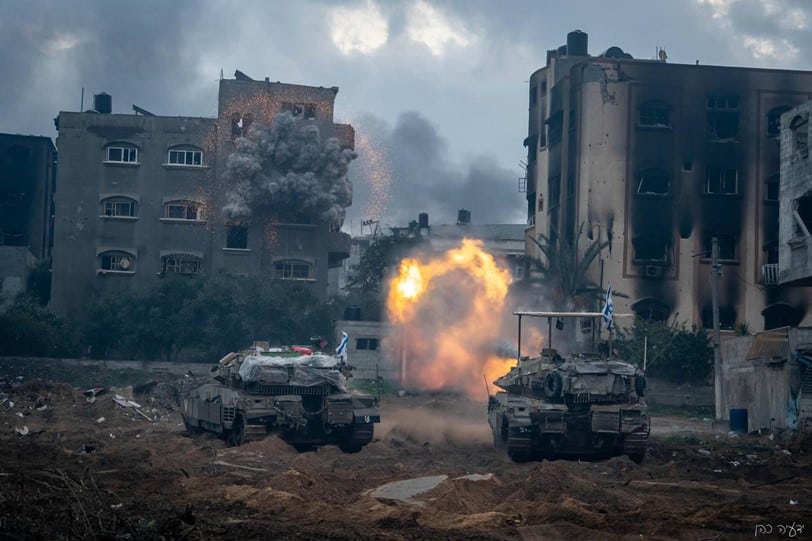
Overview
• During this week, the IDF managed to gain operational control of the Shuja’iyya neighborhood and has gone house to house to clear booby traps and other IEDs that Hamas terrorists have used to attempt to kill soldiers. The IDF gained control of the Issa outpost in Southern Gaza City and has ordered residents of the Bureij refugee camp to evacuate to Dir El Balah area as it encircles the last remaining footholds of Hamas in Gaza City.
• The IDF estimates that the number of Hamas terrorists killed since the ground operations stands at 8000.
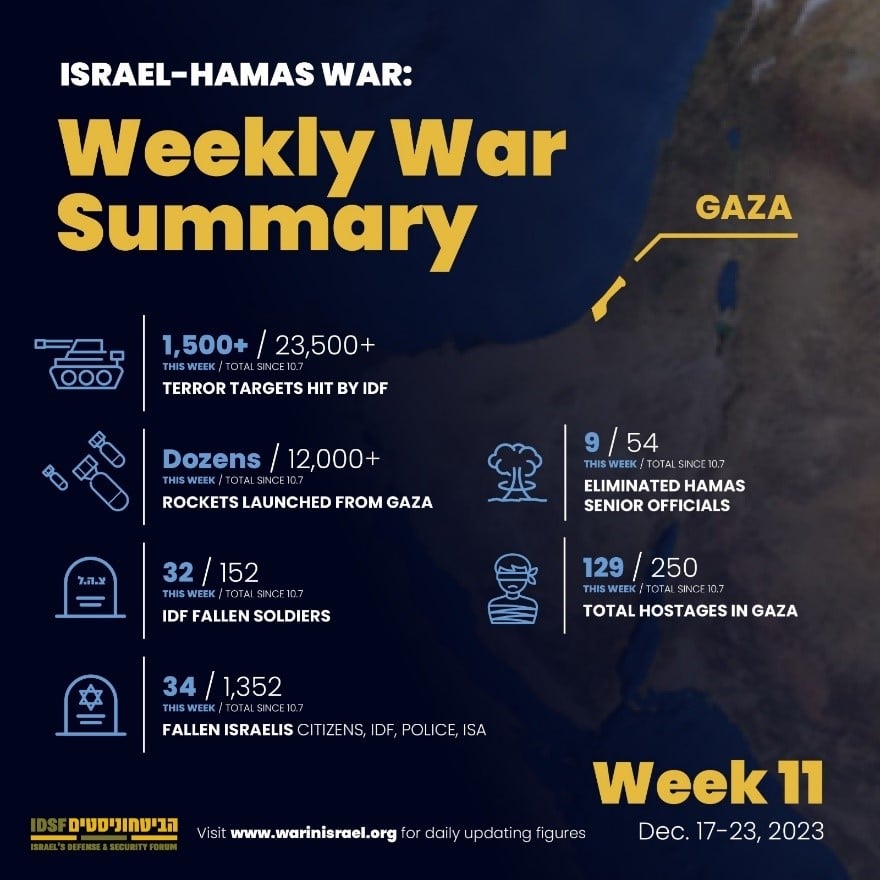
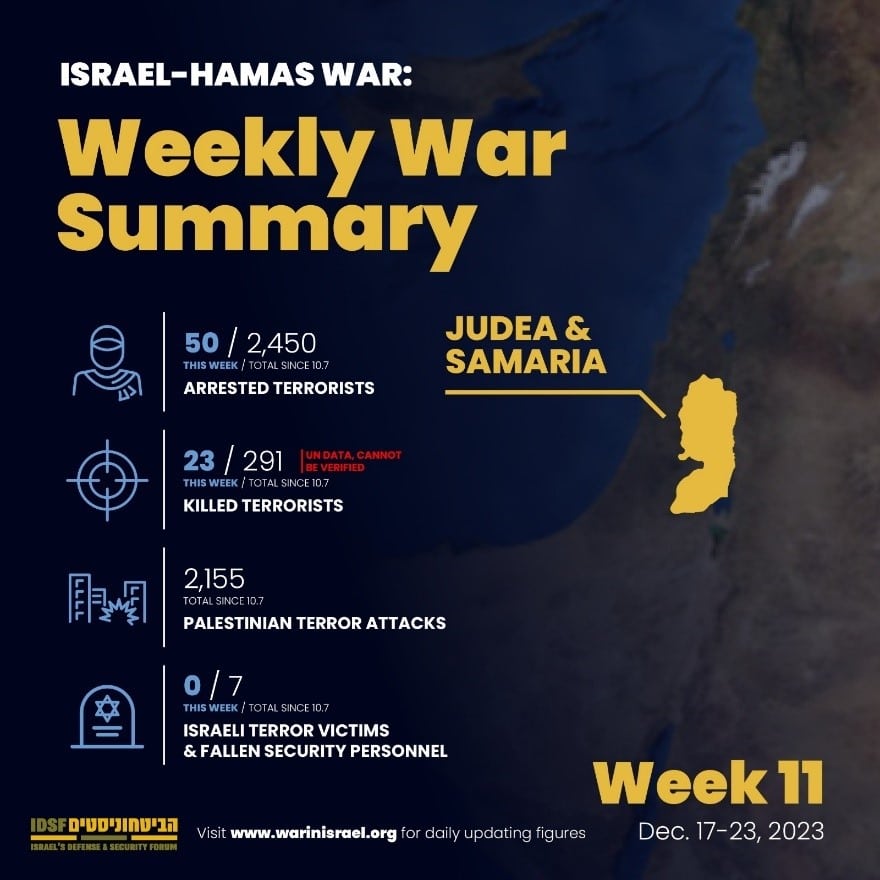
• The main focus of fighting now is in the southern city of Khan Younis, where the IDF believes that Hamas’ Gaza Leader Yahya Sinwar and the Hamas leadership is hiding.
• The main battle areas that remain at this stage are Nuseirat refugee camp, Khan Younis and some resistance pockets in Gaza City. Nuseirat refugee camp contains the command center for the local Hamas battalion. Dir el Balah remains standing with Hamas’ operational brigade still operating there. The IDF could finish clearing the area in the next couple of days, as it has captured in the North.

• After the unfortunate incident, in which 3 hostages were shot by the IDF inadvertently misidentifying them as a threat, the IDF announced it would conduct a military investigation of the incident. The soldiers are operating in an area where the terrorists use every opportunity to deceive the soldiers such as using speakers with Hebrew recordings to lure soldiers in to a trap. Hamas operatives continue to operate in civilian clothes, reportedly to disguise themselves as hostages.
• American Israeli Gadi Haggai, aged 73 was executed in Hamas captivity. He is the first American hostage to be murdered by Hamas.
• The Lebanese front escalated over the weekend with dozens of RPGs, mortars and Anti-Tank missiles launched at IDF posts and civilian cities (that have been mostly evacuated). IDF retaliated with artillery fire and IAF attacks to the source of fire. One IDF soldier was killed and 2 were injured. The evacuated communities’ houses were severely damaged- over half the houses in Kibbutz Manara and more than 100 houses in Metula.
• One of the captured prisoners from the strip, a hospital manager affiliated with Hamas, has confessed that the hospital has been turned into a terror base by Hamas with at least 16 medical staff that are also part of Al Qassam brigades. The hospital was used as a place of hiding for Hamas officials and has many tunnels connecting to it. This week, over 200 Gazan terror operatives were captured by the IDF for ISA interrogations. In total, over 700 Hamas members were captured in Gaza since the beginning of the war.
• The IDF uncovered a massive Hamas tunnel, wide enough for vehicles to drive through. The tunnel was over 4 km long and its opening only 200 meters from the Israeli border. The IDF has released videos and allowed foreign journalists to come and visit the tunnel.
• For the first time, the US has blamed Iran for their involvement in the Houthi attacks by providing intelligence about cargo ships in the Red Sea.
• Secretary Lloyd Austin has announced “Operation Prosperity” to protect the freedom of navigation in the Red Sea and the Bab el Mandeb straits with a US-led international coalition. The operation will be operated by CENTCOM.
• Josep Borrell, EU’s VP/HR and Head of the EEAS claimed that too many civilians were being killed in the Gaza Strip and that they had witnessed a “horrific lack of distinction” in Israel’s military operation.
• Seven people, including four suspected Hamas terrorist operatives, were detained in several European countries on suspicion of planning to attack Jewish institutions.
• Hamas delegation led by Ismail Haniyyeh arrived in Cairo and met with Egypt’s head of General Intelligence after Haniyyeh met with Iran’s Foreign Minister, Amir Abdollahian, in Doha, Qatar the previous day.
• Hamas has made statements about being open to a rapprochement with Fatah and other Palestinian factions in dealing with the situation in order to reorganize the “Palestinian home”, a rare statement to be made by Hamas.
• Hussein al-Sheikh, secretary of the PLO’s Executive Committee claimed that the PA was the first one to defend the “resistance” and that any reform in the PA would be decided by Palestinians rather than Israeli or Americans.
Gaza Strip
• This week, the IDF announced that the Jabalia refugee camp, a hornet’s nest of terrorists, has been conquered and cleared. Over 500 Hamas terrorists surrendered and captured for interrogation by Unit 504 and the ISA. According to the IDF, Hamas’ northern brigade has almost been completely decimated and the second one destroyed. These are the two Hamas brigades north to the Wadi Gaza River splitting the strip into two areas. The Shuja’iyya neighborhood, while severely afflicted, is requiring more operational activity to reach that stage of being completely controlled and is being gradually cleared. However, the IDF has announced that it gained operational control over it.
• Shaldag, one of the IDF’s Elite commando Unit, has uncovered Hamas’ strategic tunnel network underneath “Palestine Square” in central Gaza City. Several weeks beforehand, this was the scene of hostage releases, as Israeli hostages were transferred from victorious-looking Hamas operatives to the Red Cross as the Gaza masses were cheering them on; now, the IDF has taken over the area. The IDF has released footage of the tunnel fighting underground. This network was connected to the houses of senior Hamas officials such as Def and Sinwar, who had elevator shafts connecting the tunnels to their homes.
• The IDF spokesperson has released a video of the web of tunnels in the Issa area in the southern part of Gaza City; the tunnel network served as an underground post and numerous buildings used as Hamas headquarters were destroyed.
• The IDF is continuing to clear houses in the areas it captures in Rimal, Jabalia and Bet Hanoun to make sure that no tunnel opening is left unchecked. Troops are continuing to find stockpiles of weapons in residential homes during their clearing operations.
• In Gaza City, the IDF successfully deceived Hamas terrorists to run towards a Hamas operational room which was later bombed by the IAF. The IDF also eliminated Hasan Al Atrash, the Hamas commander responsible for procurement of weapons for the Al Qassam Brigades.
• Hamas has expanded its operatives and now uses women and children as reconnaissance in Khan Younis. IDF troops have reported that these “civilians” are making contact with IDF troops before a Hamas force attacks them with their families being used as human shields. The IDF estimates that since the second stage of maneuvering in Kahn Younis and southern Gaza, 1,300 Hamas terrorists have been killed. The city is still not surrounded, and many civilians have not evacuated which makes the fighting much more difficult and costly for civilians and IDF troops.
• The IDF has had localized raids into the central Gaza strip in Dir El Balah where a Hamas brigade is still operational. This hints that the next stage of the maneuvering would focus on clearing the Dir El Balah area.
• Some of the tunnels were located underneath children’s beds in residential apartments.
• IDF troops found 5 Millon NIS in cash and other weapons in a Hamas official’s residence in the Jabalia area. This is one of the largest ever single catch of terror funds in cash. The IDF has also found over 30,000 Hamas rockets and anti-tank missiles.
• Out of the 700 operatives captured in Gaza, 70 are part of the Nukhba force that perpetrated the October 7th massacre.
• On Tuesday and Thursday, Hamas launched over 40 rockets into suburban Tel Aviv (Gush Dan) after an IDF operational activity claimed the life of one of the organization’s senior members. Israel has offered Hamas to restart a hostage deal which according to reports included the release of 40 Israeli hostages in exchange for a two week-long truce. Hamas refused and said that it is imperative to include a total cessation of hostilities in any possible deal. To taunt Israel, Hamas released a video of 3 elderly hostages in their 80’s begging to be released. Later in the week, Hamas reported the three were killed during air raids, a claim that could not have been corroborated. Hamas has used this psychological warfare multiple times during the war.

• Negotiations included a meeting between CIA chief, William Burns, and Mossad Director David Barnea after the latter met with the Qatari PM to find a formula for a new hostage deal. The trio met again in Warsaw after which Biden stated that no deal is currently on the table.
• A bipartisan letter was sent to Biden by Sen. Joni Ernst (R-IA) and Sen. Jacky Rosen (D-NV.) asking him to pressure Qatar to move the hostage deal forward, citing concerns that Qatar is not using its leverage to push for a deal. The letter also suggested that if Qatar fails to pursue a deal, it should impact its relationship with the US.
The Day After in Gaza
• The Biden Administration is gradually unveiling its vision for post-war Gaza as National Security Advisor, Jake Sullivan, met with PA Chairman Mahmoud Abbas to discuss a return of the PA to Gaza. The US is showing interest in reinstating a “revitalized Palestinian Authority”, to use President Biden’s term from his Op-Ed in the Washington Post, and strengthening its security forces for governing the Gaza Strip over the coming months.
• The US would like the PA to take steps so that the PA would be “more credible, more authentic, and more accountable,” according to John Kirby. Biden Administration officials have said that the PA forces, trained by the US, are effective and would be capable of assuming a role in Gaza. The administration has been discussing with the Palestinian Authority re-activating some of the members of its security forces who live in Gaza and who were on active duty until Hamas took over the enclave in a military coup in June 2007. According to a source, the Palestinian Authority reached out to some of those still at an eligible age for service to see if they were potentially interested in returning to service. It is worth noting that many former PA security forces joined Hamas after the 2007 Hamas coup in Gaza. A senior Israeli official said Sullivan did not raise the idea of re-activating Palestinian Authority security forces in his talks in Israel, which raises questions if the Administration is really pursuing what it says publicly.
• In a meeting between US Defense Secretary Lloyd Austin to the Israeli government, Austin reiterated the Administration’s position that Israel should improve its track record in civilian casualties by using less aerial bombardment and using more ground forces.
• Israel’s National Security Advisor, has released a piece in an English Arabic newspaper repeating the Biden Administration stance that Jerusalem would be willing to accept PA control over Gaza after the war assuming that it reforms itself. This stance was quickly rejected by the senior Israeli leadership.
• It is worth mentioning that the notion of reinstating the PA in Gaza has been ruled out by the Israeli government, as well as its opposition leader and most of the Israeli public according to polls. It is also unlikely given the PA’s lack of legitimacy among the Palestinian street (see IDSF – “Praiseworthy Attack”: How the Palestinian Authority and Fatah Reacted to October 7 and Why They Cannot Govern Gaza).

Lebanon
• As part of the negotiations between Jerusalem and Washington, Jerusalem has been pushing for a settlement in which Hezbollah would be located north of the Litani River in accordance with UN Security Council resolution 1701 (see – IDSF, “What is UN Security Council Resolution 1701?”).
• Hezbollah attacks continued, which included the launching of rockets at northern cities, towns, and villages, including a rocket launched from Syria. Hezbollah’s attacks included Burkan rockets (with a 300-500 kg warhead) on the Israeli Nurit military post.
• Hamas’ Lebanon wing claimed responsibility for the barrage of rockets on the Israeli northern town of Kiryat Shemona.
• Hezbollah continued to launch rocket and mortars targeting IDF posts. Two IDF soldiers were wounded and one was killed.
• Lebanese media reported IDF attacks deep into Lebanese territory, about 25 kilometers north of Metula.
• Catherine Colonna, the French foreign minister visited Lebanon and met with Aroldo Lazaro, the UNIFIL commander. France is aiming to use diplomacy to cool the situation. The minister reiterated France’s support of UNIFIL’s activities for the sake of peace and stability in the region.
The International front
• The UK and Germany are tempering their support for Israel. David Cameron and Annalena Baerbock release a joint article calling for “sustainable cease-fire” in Gaza. It is the first time that both countries have used the term “ceasefire”.
• UN Security Council to boost aid for Gaza is to be supported by the US given that no independent UN mechanism is created to inspect aid. The vote passed 13-0 with US abstaining after reaching an agreement about the phrasing of the resolution with Egypt and UAE. The text urged ‘creating conditions for sustainable cessation of hostilities.
Judea and Samaria
• Saleh Al Arouri, Hamas’ Deputy Leader, released videos via telegram calling on Palestinians in Judea and Samaria to join the fight and commit terror attacks against Jewish settlers. He refers to them as the soft underbelly of the enemy.
• A stabbing attack against a soldier in Rantis. The terrorist was later caught.
• Hamas begins to adopt a propaganda campaign to win hearts and minds of Palestinians in Judea and Samaria that mirrors the Israeli narrative surrounding the events and aftermath of October 7th. Hamas frames October 7th as the day the aggression starts against the Palestinian people. Hamas refers to the detained terrorists and those awaiting trials in Israeli prisons as “hostages,” emphasizing women and children- countering the Israeli campaign for the release of Israeli hostages in Hamas captivity. It focuses on the humanitarian conditions of the “hostages” held in Israeli prisons.
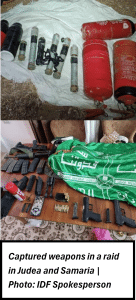
• Hamas is trying to provoke the Palestinian street in Judea and Samaria and East Jerusalem by calling for a “March of a Million” to Jerusalem to protect Al Aqsa on Friday December 22nd . This is all done under the often-used pretext that “Al Aqsa is in danger”. This call hardly produced the result Hamas was hoping for.
• During the weekend, IDF, ISA, and Border Police arrested 20 wanted operatives, 8 of which are members of Hamas. They found IEDs, explosives, an M16 and other weapons. Since the beginning of the war, 2420 Palestinian suspects have been arrested, half of whom are members of Hamas.
Syria and Iraq
• The Jordanian Air Force has carried out air strikes in southern Syria. These areas are controlled by Iranian-affiliated militias that are trafficking drugs into Jordan, most notably Captagon. This adds to Jordan’s raids on smugglers that attempted to smuggle weapons including rifles and rockets to Iranian backed cells in Judea and Samaria via Jordan.
• Iraqi Prime Minister Mohammad Shia’ al-Sudani met in Baghdad with Victoria Nuland, the American Under Secretary of State. Sudani stressed his government’s responsibility of security in its territory and its disapproval of actions taken by “external elements” in Iraq, referring to pro-Iranian militias.
• An attack was reportedly carried out against the Ain al-Assad base in western Iraq, an Iraqi base. Islamic Resistance in Iraq claimed responsibility for several drone attacks against American bases in Syria and Iraq.
• Michael Kurilla, commander of the US Army’s Central Command (CENTCOM), visited Iraq and Syria and met with senior administration officials.
• Spokesperson for Iranian-backed Iraqi militia Ashab al Kahf Abu Murtaja al Husseini said that the Islamic Resistance in Iraq will reject any discussion on stopping attacks targeting US positions in Iraq.
• Islamic Resistance in Iraq sent a drone attack on Eilat, the drone was intercepted over Jordan by the Jordanian Armed Forces.
Yemen
• There have been 34 attacks by the Houthis since the start of the war, including 26 in December including 16 UAV attacks.
• Secretary Lloyd Austin has announced “Operation Prosperity” to protect the freedom of navigation in the Red Sea and the Bab el Mandeb straits with a US-led international coalition. The operation will be operated by CENTCOM. The task force includes as of now forces from the US, Canada, Italy, Norway, Netherlands, France, UK, Spain, Bahrain, and Seychelles. There are 10 other countries that have not been publicly announced. Egypt and Saudi Arabia are not publicly part of the coalition.
• Operation Prosperity Guardian will operate under Combined Maritime Task Force 153, which was established in April 2022 to improve maritime security in the Red Sea. As a result of the Houthi threat on oil tankers (over 10% of seaborn oil passes through the Red Sea), many shipping companies are rerouting their lanes around Africa’s Cape Hope. This will cause a spike in oil prices and disrupt global supply chains.
• Once again, an oil tanker was struck by a UAV 200 KM off the Indian city Veraval. The ship came from Saudi Arabia towards India and has been claimed to have an Israeli connection. Iran has been blamed for the incident. General Mohammad-Reza Naghdi, Deputy IRGC Commander-in-Chief for Coordination has threatened to also disrupt shipping routes in the Mediterranean and Straits of Gibraltar.
• The Houthis have boasted that they managed to influence more international shipping companies to reroute their shipment routes around Africa. A Chinese shipping company has succumbed to the pressure and said they would not ship to Israel. The Houthis disruption of one of the most important navigations routes in the world could potentially hinder global supply chains and affect the prices of imported goods. This has global implications, well beyond Israel.
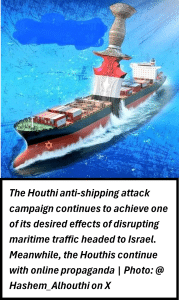
• The Houthis have also ramped up their rhetoric in reaction to the Naval Task Force that the US is creating by threatening to attack American ships.
• Egypt, struggling with an economic crisis is estimated to have lost over $100 million in revenues from rerouting ships around Africa instead of through the Suez Canal.
• The Houthis claimed to have conducted two drone attacks targeting the Norwegian-owned, Cayman Islands-flagged Swan Atlantic tanker and Swiss-owned, Panama-flagged MSC Clara container ship in the Red Sea on December 18.
• Over 100 cargo ships have rerouted their routes.
• Malaysia’s PM has announced that Israeli shipping company Zim would not be allowed to dock at their ports due to the war.